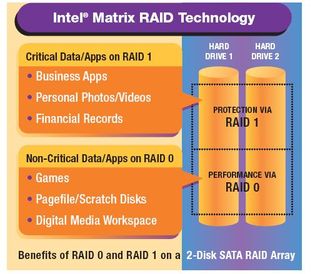Intel's 955X Dual-Core Chipset Better For Business Users Than NVidia's nForce4
Intel Matrix Storage Technology: Now Includes RAID 5

With the introduction of 915 and 925 chipsets, Intel also delivered a new, more flexible storage controller described as Matrix Storage Technology. Fundamentally, it enables support of multiple simultaneous RAID arrays, based on the same sets of drives. A RAID array uses multiple drives simultaneously, to increase the disk subsystem performance while also improving data security from drive failures or defects.
At the same time, two Serial ATA connections were available, so that a Matrix-RAID array could itself be composed of two RAID 0 or RAID 1 arrays. With the 945P and 955X, four SATA ports stand ready and Intel uses them to offer still more options. With three SATA drives installed, the Southbridge ICH7-R supports a single RAID 5 array; with four, RAID 5 and RAID 10 are both possible. RAID 0 works with up to four SATA drives, while RAID 1 still works only with pairs of such drives.
One interesting aspect of these various features (as shown in the figure at the head of this section) is the combination of a fast array (for example, RAID 0) with a redundant array (such as RAID 1 or 5). In deploying pairs of drives, a RAID 0 array handles the operating system and data storage operations. A follow-on RAID 1 array can preserve transactions, and even capture a system image for fast recovery.
With four drives all these options become possible, so that a RAID 0 and a RAID 5 array can be combined with ease. Three drives represent the barest minimum for RAID 5 anyway, to accommodate safe storage of parity data on enough drives to withstand the loss of any single drive.
For those who want to start small, the Intel Matrix Storage Manager driver appears during the drive controller specification phase of Windows installation. With this driver, vendors can support numerous migration models, including upgrading a single drive to a RAID array or adding an additional drive to an existing RAID array.
The SATA Controller now supports Native Command Queuing as well as 300 MB/s transfer rates for each SATA port. The latter has little real impact today, because disk drives offer transfer rates of under 80 MB/s and direct Read/Write from the drive cache offers no noticeable boost to performance.
The SATA controllers in the ICH7 Southbridge now accommodate Advanced Host Controller Interface (ICHI) compatible devices. The actual 1.1 specification describes this interface at the register level and enables widespread standardization of SATA-II controllers. Because earlier implementations worked on proprietary schemes, this could be important for future efficiencies resulting from use of command queuing. Right now, it's too early to prove or disprove this contention. Faster future drives, however, may make a big difference.
Stay on the Cutting Edge
Join the experts who read Tom's Hardware for the inside track on enthusiast PC tech news — and have for over 25 years. We'll send breaking news and in-depth reviews of CPUs, GPUs, AI, maker hardware and more straight to your inbox.
Current page: Intel Matrix Storage Technology: Now Includes RAID 5
Prev Page 955X Versus 945P Next Page Intel Active Management TechnologyMost Popular

